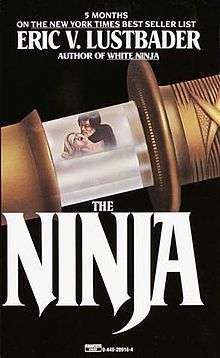The Ninja (novel)
 Cover to the 1990 mass market paperback edition | |
| Author | Eric Van Lustbader |
|---|---|
| Country | United States |
| Language | English |
| Genre | Thriller, Crime novel |
| Publisher | M Evans & Co |
Publication date | April 1980 |
| Media type | Print (Hardcover, Paperback) |
| Pages | 442 pp (hardcover edition) |
| ISBN | 0-87131-314-6 (hardcover edition) |
| OCLC | 5830611 |
| 813/.5/4 | |
| LC Class | PZ4.L9696 Ni PS3562.U752 |
The Ninja novel was written in 1980 by Eric Van Lustbader and is a tale of revenge, love and murder. The author blends a number of known themes together: crime, suspense and Japanese martial arts mysticism. The book is divided into five parts, called "rings," as an apparent homage to Miyamoto Musashi's The Book of Five Rings.
Plot summary
It is initially set in Japan following the end of World War II and follows the story of Lustbader's hero Nicholas Linnear, a man raised by Anglo-Chinese parents.
As a youth, Linnear is introduced to the world of aikido, kenjutsu, and iai-jutsu at a local dojo of the Itto Ryu also attended by his cruel and violent older cousin Saigō. Linnear is a natural and soon becomes adept, much to the annoyance of Saigō. During a training exercise Nicholas and Saigō duel and Nicholas defeats him. Saigō is enraged and leaves swearing revenge.
When they next meet Saigō is a considerably more skilled martial artist than Linnear and defeats him quickly. Later we learn Saigō has joined a Kuji-kiri ryu in order to learn black ninjutsu and has become a ninja.
Linnear himself soon becomes introduced to Aka i ninjutsu, or the red, ostensibly "good" side of ninjutsu, through the Tenshin Shoden Katori Shinto Ryu.
The ninja are introduced not as magical or almost mythical people, but rather as supreme martial artists who have reached the highest level and seek to progress further. It is suggested that by becoming ninja they strive to advance to an even higher plane, gaining skills such as haragei, or sensing the surrounding world in a different manner. However, we soon learn this is not without a high personal cost.
Many years later, Linnear has moved to America and leads a peaceful academic existence. After quitting his job in advertising, he meets a beautiful, if disturbed, woman called Justine with whom he falls in love. This peace is shattered when a prominent local businessman is murdered in an extremely unusual manner (by a poisoned ninja shuriken). The local police are baffled and consult Nicholas as he is known to be an authority on oriental studies. Linnear quickly realises that a ninja is the murderer and the next target is his new girlfriend's father, Raphael Tomkin, whom he begins working for as a bodyguard, although not without persuasion. Linnear also befriends Lew Croaker, a local detective.
Linnear's investigations reveal Saigō is the ninja and this puts him on a deadly collision course with his older cousin.
Characters
Linnear and Saigō are portrayed as opposites. Linnear is a somewhat cold hero, and Saigō is a violent and dangerous foe. Both are equally skilled in their disciplines, differing only in the philosophy that drives them. Both men are troubled. Saigō battles with his inner demon of self-doubt, often resorting to mind-expanding drugs, whilst Nicholas is a man torn between two worlds and feeling he belongs to neither.
Unmade Film Adaptation
Originally in the 1980s, the rights to make a film adaptation were bought by producers Richard D. Zanuck and David Brown for 20th Century Fox to produce.
Irvin Kershner was hired to direct, with a screenplay by W.D. Richter which follows very close to the novel itself. Tom Cole was hired to write a draft, even Kershner wrote a draft himself, but for unknown reasons, he was replaced with John Carpenter to direct the picture, he had co-wrote a second draft with Tommy Lee Wallace in 1983. By around the same time, Joe Wizan who had become the new head of Fox, had put the projects including The Ninja that were given the green-lit, on a turnaround, which this had caused Zanuck and Brown to quit at Fox and went to Warner Brothers.